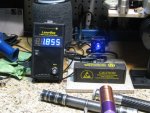Hey everyone,
Sorry if there was already a post about this, I did use the search function but didn't find much stuff.
Anyways I bought two SLD3134VL 20mw 405nm diodes from eBay and they arrived in plastic packaging (not even in antiESD bags).
So I tried out one of the diodes by using a constant current driver built from an LM317. The diode needs 32mA (max rating) so I used a 40 ohm resistor between the adjust and output pin (I put one 47 ohm and one 270 ohm resistor in parallel). I powered the driver using 11V and connected the diode (LD anode to +, common to -) but it wasn't very bright. Next I tried the other diode and it was super bright for a split second and then it fried.
So I'm not sure if I'm giving too much current to the diodes (maybe the tolerance of the resistors is too large?) or if the diodes are somehow faulty or got damaged (maybe ESD damage?).
Does anyone know what I did wrong? Or if the diodes are actually faulty does anyone know any reliable sources to get decent powered 405nm diodes?
Thanks everyone
Sorry if there was already a post about this, I did use the search function but didn't find much stuff.
Anyways I bought two SLD3134VL 20mw 405nm diodes from eBay and they arrived in plastic packaging (not even in antiESD bags).
So I tried out one of the diodes by using a constant current driver built from an LM317. The diode needs 32mA (max rating) so I used a 40 ohm resistor between the adjust and output pin (I put one 47 ohm and one 270 ohm resistor in parallel). I powered the driver using 11V and connected the diode (LD anode to +, common to -) but it wasn't very bright. Next I tried the other diode and it was super bright for a split second and then it fried.
So I'm not sure if I'm giving too much current to the diodes (maybe the tolerance of the resistors is too large?) or if the diodes are somehow faulty or got damaged (maybe ESD damage?).
Does anyone know what I did wrong? Or if the diodes are actually faulty does anyone know any reliable sources to get decent powered 405nm diodes?
Thanks everyone






